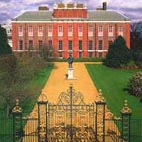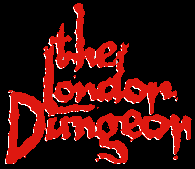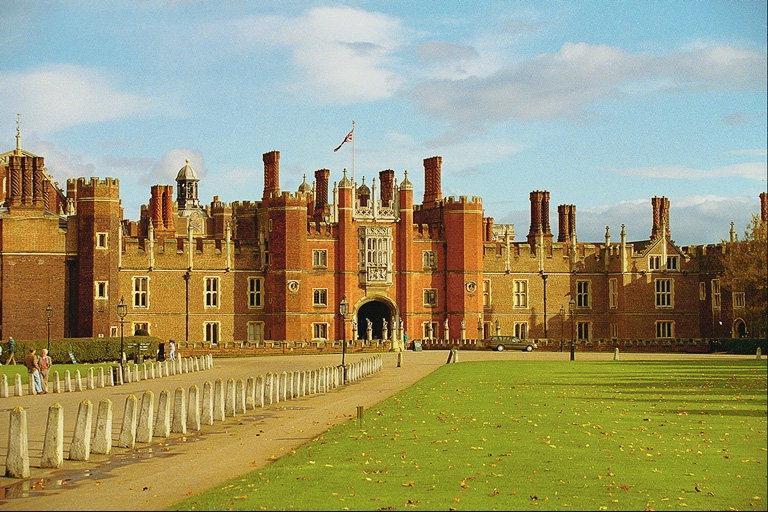|
  London
Airport & Tourist Guide.
click on a
link below for further information... London
Airport & Tourist Guide.
click on a
link below for further information... |
Click
on the links below...
|
Click
on the links below...
|

What
to see - Tourist Trail |
LONDON - for the Chocoholic...
Next time you're in Notting Hill or Portobello Antique Market, in West London, make your way to Westbourne Grove for a chocoholic's ultimate fix. 'Artisan du Chocolat' have just opened a rather smart chocolateria at 81 Westbourne Grove with a menu chocoholics can only normally dream about. They have hot fondant, salted caramel chocolate tart, chocolate mousse, fresh fruits dipped in melted chocolate and a tasting platter of chocolates. Ask them about their tasting evening! (Held once a month for around £35 per person).
Master Chocolatier, Nick Strangeway, has taken the pulp surrounding the cocoa beans (with the texture of lychees and the taste of strong apple) to create a Bellini, and also a classic New Orleans Fizz with his signature white drinking chocolate. You can also enjoy a chocolate martini, and for those who enjoy chocolate without the alcoholic kick, there's a non-alcoholic chocolate granitas - both you can enjoy at the tables outside this establishment.
Enjoy!!!
www.artisanduchocolat.com |
Buckingham
Palace.
 Buckingham
House was built for the Duke of Buckingham in 1703. George III
purchased the house in 1762 and used it as one of the royal family's
London homes. George IV employed John Nash to build a new palace
round the old house. Nash designed the building with Marble Arch
as the main entrance. Marble Arch was later moved to Hyde Park.
It was not until 1837 that Queen Victoria made Buckingham Palace
the royal family's principal London residence. When visiting see
if the Union Jack flag is flying. The other flag you may see is
the Queens Standard, this will mean the Queen is in residence. Buckingham
House was built for the Duke of Buckingham in 1703. George III
purchased the house in 1762 and used it as one of the royal family's
London homes. George IV employed John Nash to build a new palace
round the old house. Nash designed the building with Marble Arch
as the main entrance. Marble Arch was later moved to Hyde Park.
It was not until 1837 that Queen Victoria made Buckingham Palace
the royal family's principal London residence. When visiting see
if the Union Jack flag is flying. The other flag you may see is
the Queens Standard, this will mean the Queen is in residence.
Link
to British Royal Family website below these articles |
Tower
Bridge.
Tower Bridge has a fascinating history, which is explored in full
in The Tower Bridge Experience. Here are a few interesting facts
you may not have known:
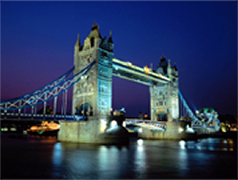 Tower Bridge was completed in 1894, after 8 years of construction. Tower Bridge was completed in 1894, after 8 years of construction.
1910 - the high-level walkways, which were designed so that the
public could still cross the bridge when it was raised, were closed
down due to lack of use. Most people preferred to wait at the
bottom and watch the bascules rise up!
1912 - during an emergency, Frank McClean had to fly between the
bascules and the high-level walkways in his Short biplane, to
avoid an accident.
1952 - a London bus had to leap from one bascule to the other
when the bridge began to rise with the bus still on it.
1977 - Tower Bridge was painted red, white and blue to celebrate
the Queen's Silver Jubilee. (Before that, it was painted a chocolate
brown colour).
1982 - Tower Bridge opened to the public for the first time since
1910, with a permanent exhibition inside called The Tower Bridge
Experience.
Tower Bridge is one of the world's most famous bridges. 150,000
vehicles cross it every day. Over 900 times a year the roadway
parts and lifts to let tall ships, cruise liners and other large
craft pass through.
Click
on picture for website
|
St.
Paul's
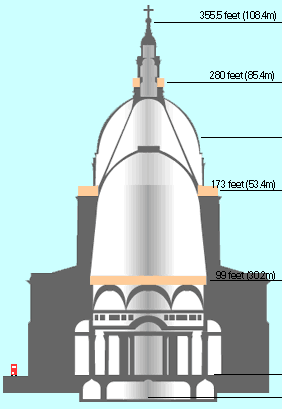 The
first church on this spot was erected in 604 AD. This wooden church
was established by King Ethelbert of Kent as home to the first
bishop of the East Saxons, Mellitus. This church was destroyed
by fire and rebuilt by St. Erkenwald, then bishop, in 675-85.
Fire was not the only danger faced by buildings in those dark
centuries of Anglo-Saxon England - the Vikings destroyed the second
St. Paul's in 962 during on of their periodic invasions. Once
again, fire destroyed the third church in 1087. A new fourth church,
a Norman building, now called Old St. Paul's, took over 150 years
to complete, the final touches being applied in 1240. Well, not
quite final touches - a new Gothic choir was added by 1313, making
St. Paul's the third longest church in Europe at 596 feet. The
following year the spire was completed. At 489 feet it was the
tallest in all Europe. In the Tudor period an open-air pulpit
called Paul's Cross was established by the south wall of St. Paul's.
There crowds gathered to hear rabble-rousing Protestant sermons.
In 1549 the preachers incited a mob to sack the cathedral itself.
They rampaged through the interior, destroying the high altar
and ravaging the tombs, wall-hangings, and tombs. Then the spire
was struck by lightning, as it towered over the city. The
first church on this spot was erected in 604 AD. This wooden church
was established by King Ethelbert of Kent as home to the first
bishop of the East Saxons, Mellitus. This church was destroyed
by fire and rebuilt by St. Erkenwald, then bishop, in 675-85.
Fire was not the only danger faced by buildings in those dark
centuries of Anglo-Saxon England - the Vikings destroyed the second
St. Paul's in 962 during on of their periodic invasions. Once
again, fire destroyed the third church in 1087. A new fourth church,
a Norman building, now called Old St. Paul's, took over 150 years
to complete, the final touches being applied in 1240. Well, not
quite final touches - a new Gothic choir was added by 1313, making
St. Paul's the third longest church in Europe at 596 feet. The
following year the spire was completed. At 489 feet it was the
tallest in all Europe. In the Tudor period an open-air pulpit
called Paul's Cross was established by the south wall of St. Paul's.
There crowds gathered to hear rabble-rousing Protestant sermons.
In 1549 the preachers incited a mob to sack the cathedral itself.
They rampaged through the interior, destroying the high altar
and ravaging the tombs, wall-hangings, and tombs. Then the spire
was struck by lightning, as it towered over the city.
The church fell into decline for a few years despite efforts to
renovate it. During the English Civil War, Parliamentary troops
commandeered the cathedral and used the nave as cavalry barracks.
They broke up the scaffolding and sold the material.
The fortunes of Old St. Paul's seemed to take a turn for the better
with the Restoration of the Monarchy in 1660. Charles II appointed
a young architect named Christopher Wren to undertake major repairs
to the building. Wren had only begun his work when final calamity
struck.
On September 4, 1666, fire broke out in a bakehouse in Pudding
Lane. Fanned by a fierce wind, the fire spread through the close-packed
streets of London, destroying everything in its path. For four
days the fire raged, and when the smoke finally cleared, Old St.
Paul's was nothing but charred timbers and rubble.
Wren's first two designs for the cathedral were rejected by the
church as being too modern. & the second design was rejected
for being too Italian (i.e.. Catholic). The scale model of this
design, is in the crypt of the present St. Paul's.
Finally in 1675 Wren gave the clergy what they wanted; a traditional
English church design with a long nave and spire. The king granted
Wren a royal warrant approving this design with the interesting
proviso that the architect was free to make "variations,
rather ornamental than essential".(A free hand to Wren!)
On the strength of the Royal Warrant Wren proceeded to quietly
change just about every essential element of the design the clergy
thought they were getting. He got rid of three bays in the nave,
did away with the spire, enlarged the dome, and raised the aisle
walls.
Much of this work proceeded behind scaffolding and protected from
prying eyes. By the time the furious clergy realized what Wren
had done the church was too far gone to be altered.
When stone was laid for the centre of the new building, stones
from the Old St. Paul's were used. Wren noticed that one of the
stones was marked with the Latin inscription "resurgam",
"I shall rise again". He had the word inscribed on the
pediment of the south door, beneath a carved phoenix.
From the laying of the first stone in 1675 to the final touches
in 1708, the cathedral was finished in a mere 33 years. St. Paul's
is alone among English cathedrals as just one man's creative vision.
Click
on picture for website
|
Palace
of Westminster
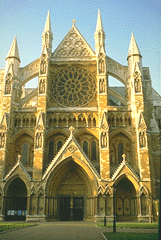 The
Palace of Westminster was the principal residence of the kings
of England from the middle of the 11th century until 1512. In
medieval times kings summoned their courts wherever they happened
to be. But by the end of the 14th century the court in all its
aspects - administrative, judicial and parliamentary - had its
headquarters at Westminster. The
Palace of Westminster was the principal residence of the kings
of England from the middle of the 11th century until 1512. In
medieval times kings summoned their courts wherever they happened
to be. But by the end of the 14th century the court in all its
aspects - administrative, judicial and parliamentary - had its
headquarters at Westminster.
The Mediaeval Hall (Westminster)
William I, having established his first stronghold at the Tower,
later moved to Westminster; and it is from the reign of his son,
William Rufus, that the first extant buildings on the site date,
including Westminster Hall, the Great Hall, which was built at
the northern end of the Palace and still stands today after celebrating
nine hundred years of continuous use in 1999.
The hall was designed originally as a place for feasting and entertaining,
but its very size made it more than that. Among other uses, the
Royal Council of bishops, nobles and ministers assembled there.
The special later form of this Council, which came to be known
as Parliament, was the forerunner of the present House of Lords.
It was also the site of the first true English parliament to include
elected representatives, summoned by Simon de Montfort in 1265.
While Parliament has never met in the Hall on a regular basis,
it was the existence of the Hall, which at that time was the largest
in Europe, that helped to make Westminster the judicial and administrative
centre of the kingdom.
The Palace was one of the monarch's principal homes throughout
the later Middle Ages, and for this reason the institutions of
Government came to be clustered in the Westminster area. To the
east and south of the Hall lay the domestic apartments of the
mediaeval Palace, and later, the royal chapel of St. Stephen.
Kings worshipped in the upper Chapel and their courtiers in the
lower level or "crypt" chapel below.
The Hall, of which the walls were built in 1097-99, as part of
an intended reconstruction of the whole palace, is the oldest
extant building on the Palace of Westminster site. Its floor area
is about 1850 sq. yds, and it is one of the largest mediaeval
halls in Europe with an unsupported roof. The roof was originally
supported by two rows of pillars, but the present magnificent
hammerbeam roof was designed in the reign of Richard II. The mason/architect
of the 14th century rebuilding was Henry Yevele, and the carpenter/designer
of the roof, Hugh Herland. Westminster Hall was the traditional
venue for Coronation banquets.
Click
on picture for website |
The
White Tower
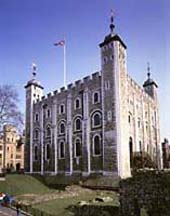 The
White Tower was not only the first building of what is known to
be the Tower of London but also it is the first stone keep in
England. Started in 1078 it replaced an earlier wooden fort built
on the site after the Norman Conquest in 1066. Its excellent strategic
position dominated the city and river, but the specific siting
was influenced by the Roman city wall The
White Tower was not only the first building of what is known to
be the Tower of London but also it is the first stone keep in
England. Started in 1078 it replaced an earlier wooden fort built
on the site after the Norman Conquest in 1066. Its excellent strategic
position dominated the city and river, but the specific siting
was influenced by the Roman city wall
To the majority of visitors to the Tower of London the resident
ravens appear to be just oversized black birds similar in appearance
to the common crow. In many ways that is what they are but to
dismiss them merely as being such would be almost the same as
passing off a Golden Retriever dog as being a larger version of
say, a King Charles Spaniel...
Legend has it that should the ravens ever leave the Tower of London
the White Tower will crumble and a great disaster shall befall
England...
Click
on picture for website
|
Kensington
Palace
Kensington Palace has been a royal home for over 300 years
and parts of the palace remain a private residence for members
of the Royal Family today. The magnificent State Apartments
and the Royal Ceremonial Dress Collection, which includes dresses
worn by HM Queen Elizabeth II and Diana, Princess of Wales,
are open to the public.
Click
on picture for website
|
|
The
London Dungeon
Deep in the heart of London, buried beneath London Bridge station,
lies the world's most chillingly famous museum of horror. The
London Dungeon brings more than 2,000 years of gruesomely authentic
history vividly back to life ....and death. As you delve into
the darkest chapters of our grim and bloody past, recreated in
all its dreadful detail, remember : everything you will experience
really happened!
Click
on picture for website
|
|
Hampton
Court Palace
For almost 200 years, Hampton Court Palace was at the centre of
court life, politics and national history. Although often identified
with Henry VIII, its history was influenced just as much by William
III and Queen Mary II in the late 17th century. Home to many of
Britain's most famous Kings & Queens, Hampton Court Palace
offer a magical visit. Don't forget to visit the famous Hampton
Court Maze - get lost where the Royal's did!
Click
on picture for website
|
|
Links
for you to follow...
London
Transport Online - For Train, Tube, Bus and Taxi/Minicabs
Information. Maps, tickets etc.
Visit
Britain - The British Tourist Authority,for all your Britain
travel requirements.
Tower
of London - Begun by William the Conqueror in 1078, the Tower
of London has served as a royal residence, fortress, mint, armoury
and more infamously as a place of execution.
London
Eye - British Airways London Eye is the world’s highest
observation wheel and offers passengers amazing views of Britain’s
capital city.
Harrods - Harrods is one of London’s most prestigious shopping venues
and certainly the top shopping Mecca for tourists.
British
History and Historical Figures -
King
Arthur - Ancient Legend, now fact - check this out!
The
Royal Family Online - Yes, you can read about the latest Royal
engagements, find out about the Order of Merit, and try a quiz
in the new Royal Insight on-line magazine.
Guy
Fawkes & the Gunpowder Plot - A insight into the English
born Traitor who tried to blow up Parliament in 1605, and the
man who is still remembered, and who's death is still celebrated,
by most of England on Guy Fawkes Night!(November 5th)
Back
to the Top
|
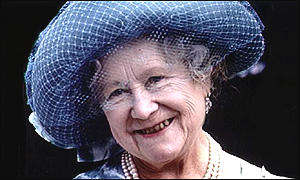
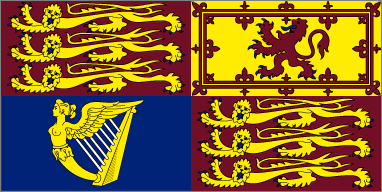
Royal Standard
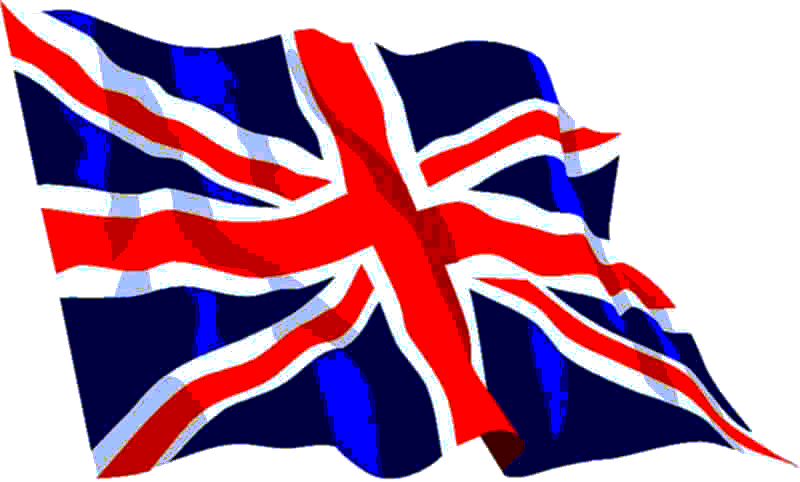
Union Jack.
|
If
you haven't got much time in London...
or
if you are going to be at Heathrow waiting for
between 4 - 10 hours for a flight connection...
Why
not consider a
'Flying Purple Pig' photo tour?
Click
our flag to the right
for more information...
|
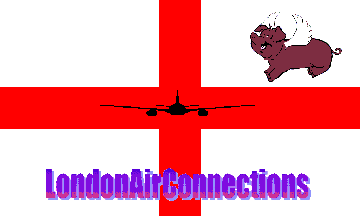
Flag
description :
Our 'Flying Purple Pig' Flag is made up of the following...
the English Flag (St. George Cross), our 'Flying Pig'
logo in the right top corner, the L.A.C. Plane through
the middle and our name Logo across the bottom to make
it complete. |
|
Flags,
the original United Kingdom, Four Countries and Londoners!* |
London
is in England & St. George is the Patron Saint of England.
You often see his flag for sport and competitions when teams are
representing their country, rather than the United Kingdoms of
England, Northern Ireland, Scotland and Wales. This United Kingdom,
or Britain as it is also known, is the original United States
in Europe! Confusion is not rare in UK, when distinguishing between
UK and Country. In the Olympics we have a British Team, in Track
and Field also. In football, cricket and rugby the four countries
have separate teams. Why? 'Just Because' - that's why! (We don't
know! -maybe someone can let us know).
Since
the UK joined the European Union, we now have yet another identity
to contend with, of course, with Europeans becoming another Union
of States. Already the Europeans have a golfing team! Where will
it end - are borders getting blurred? Perhaps this is a good thing.
Immigrants
particularly, and some UK citizens from ethnic backgrounds,
like to be called 'British' rather than Welsh, Scottish, Irish
or English! Not wanting to be classed as a member of the country
in which you live doesn't seem to go logically with integration
- but for some reason it does work! Will those British soon call
themselves Europeans instead? The UK seems to be one of the most
diverse, tolerant and racially integrated countries in the world,
and no where is this more obvious than in London.
Greeks
& Turks, Blacks & Whites, Indians & Pakistanis, Jews
& Arabs, people from all nations, all live & work side
by side in virtual harmony. If you want to know what Cyprus goodwill
was like before Cypriot separation, go to Green Lanes, North London.
If you want to see how Indian,Pakistani and Bangladesh's live
together go to the East London Market areas or to Ealing in West
London - No other City in the world can boast this active diversity
and having such non-segregation at the same time! Oh, Jews &
Arabs in this present climate? - Just go to Stamford Hill and
surrounding areas in North London, nothing special there, just
normal people - getting on together! There is even a road in Stamford
Hill called "West Bank" where Jewish, Muslims, Christians,
Arabs, Polish, English and African people live in total integration
- perhaps Israel, Egypt, Iran and Palestine could learn from this?
Obviously
some opinions differ and peaceful (mainly) protests do occur,
normally relating to problems happening overseas, but The UK Government
and London Police forces (City & Metropolitan) all take a
dim view of any discrimination of any sort. So does the average
London citizen! Also most employers in the UK have a "non-discrimination
policy"; you can be arrested for verbal abuse, let alone
physical in London. Even tenants in Council owned houses can be
evicted for Discrimination. But few people in London seem to need
these rules - 'Londoners' are a proud people - proud
of their heritage, history and also how we all all just Londoners,
whether it's here at home or abroad. Even Ethnic Londoners, who
consider themselves 'British' and not 'English', will call themselves
a Londoner! How long does it take to become a "Londoner"? Stay a few weeks with us and your probably want become one
by choice, and of course you will because anyone and everyone
who lives here, long or short term is and always will have a little
bit of London in their heart...
"There are no minorities here! - only us Londoner's."
Keith Geoffreys 2002
*This
article is an a complete original, written by the KGC Group team
and is copyright KGCGROUP - 2003
|

English Flag

Scottish Flag
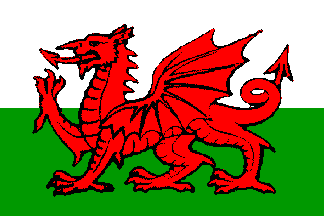
Welsh Flag

Northern
Ireland

Union (British) Flag

European Flag

United Nations Flag

The National flag of Ireland
Ireland became Independent from Britain on December 6, 1921, but
links are still strong. |
Back
to the Top |
Interesting
facts about London areas and postcodes...
1.
Postcodes are not located in Numerical Order, for instance...
SW2 is not anywhere near SW1 or SW3!
2.
The Thames River has absolutely nothing to do with whether you
are in a North or South Postcode...SW1,3,5,6,7 & 10 are
North of the Thames,but still South West Postcodes!
3.
North and South of the River Thames have strong rivalry. It's
said that when a Londoner crosses the Thames, to the other side
from which he lives, he is on Foreign Soil !!!
4.
Most of Central London is on the northern side of the Thames.
5.
Central London's average driving speed is 3-10miles an hour
during the day!
6.
Letters and Parcels, bound for London, without postcodes can
be delayed by days!!
7.
London's' temperature is always 1-3degrees higher than it's
suburbs, and normally than the whole of the UK.
8.
London's Mayor can not / does not drive a car ! (And he's responsible
for Planning London's Traffic Strategy!)
9.
The Metro Area of London has approx. 10 million people living
in it!
10.
London has it's own version of the England flag. (This is it,
though it is rarely used!)
|
Back to the Top
More
to do in a London this year? 
Diary
This
year London has managed to stay really green. The park are full of plants
and wild life, giving London a pleasant, clean atmosphere. Summer can
be mild and perhaps with a few showers of rain so beware if you plan to
walk around this great city of ours. Although, perhaps not the best weather
in the world, London is one of those cities which cannot be spoilt by
rain or cold - there's so much to do. The London Eye offers fantastic
views of the city, and with 100's of museums and exhibitions, there is
no way you can be struck for something to do.
Here is a suggestion for a day of fun for a mixed group of Teens and Older... Starting near London Bridge Station.
Try either "the London Dungeon", near London Bridge Station, if you dare. The Dungeon exhibits the nastier side of London's History - Crime & Punishment, the Plague and an exciting ride to the Gallows after you are judged to be 'Guilty' by a mad 18th century judge.
Or why not try "the London Bridge Experience" - History of London seen from the bridge, and then a visit to the tombs below the bridge where the lifeless bodies of those buried in mass graves pits during one of the plagues of medieval times reside... Bewares of Zombies!!! (Be warned this is not for the faint hearted and definitely not for Children under 12yrs!)
If you escape all this, or have avoided it all together, just a little further down Tooley Street, is the Blitz Experience. Here you can go back in history to the 1940 and experience what it was like to live in London during the Blitz of World War II. Being escorted to a Bomb shelter by an 'Air-raid Warden' as the Air-raid siren sounds, you will experience a real life Blitz raid and afterwards you will emerge into a bombed and wrecked city.
Once you come back to the 21st Century, why not cross over Tooley Street towards the river, and visit the 365 day Christmas shop or grab a bite to eat in the many modern restaurants and bars located between Tooley Street and the Thames river. Then you can walk along the river Thames on the South Embankment, (which is thoughtfully called "The South Bank!"). Walk to the ship HMS Belfast, which is now a floating museum which you may wish to visit. (HMS Belfast was the ship that fired it guns first to signal the start of the D-Day invasion of France in 1944).
Once past the Belfast, you will then see the new, and rather strange looking London Council buildings (the Mayor's Office).
More impressively, take a look a little further along and to your left and you will see Tower Bridge (the one that opens!) and just across the river is the Tower of London. Building started around 1070 on the WHite Tower in the centre, after the Battle of Hastings. Rather than defense, it was built as power base for the the Normans in and around London, and to impress them that the leadership of England had changed. If you walk up and then across Tower Bridge you can then visit the Crown Jewels and the Tower itself. Guided tours are available.
Afterwards, just across the main round towards Tower Hill Station, is a part of the old Roman London Wall, which is approximately 2000 years old! This was discovered whilst builders were removing rubble from destroyed building left over from the war in 1946. Then take a look at the Sun Dial just above the Tube/Underground Rail entrance - this shows the 2000 year history of London in pictures. Next to this is the Merchant Navy Memorial - which looks a little like the Washington Memorial, but is 30 years older and remembers those who lost their lives at sea in both world wars.
So this completes you days adventure - you can take the Tube (subway) from Tower Hill station here, back to Covent Garden perhaps for an evening meal and perhaps a West-End show? As Hemingway wrote; "Those who tire of London, are tired of life itself!" Enjoy!
Of course there are loads of things to do, check below
for few extra ideas in addition to the main tourist attractions, sites
and shows!
All
Year. The London Aquarium - Right next to the London Eye and Westminster
Bridge, the London Aquarium is one of London's exciting family attractions. Discover
fish and water life from all over the Uk and Europe right through to Sharks
and 'Rays from around the globe - there is even a petting area. (But it
gets very busy!) Three floors of Aquariums with interactive displays and
a three story SHARK TANK in the middle!!! A great day out - especially
if you have kids with you!
All
Year. NAMCO Centre - again Right next to the London Eye and Westminster
Bridge, the NAMCO Centre is the place for Fun, fun and more fun. Video
games, slot machines, bumper cars and prizes to be won. When you've had
enough get a drink in the bar and let the kids run riot!!! From the people
who brought you Pac-man, see what they have in store for you here!
All
Year. Imperial War Museum, Lambeth Road,
SE1 - One of the best War Museums in the world and a source of imformation regarding most conflicts of the 19th, 20 and 21st centuries. Also there is a World War One Trench for you to explore and lot of other exciting exhibits including Missles, Tanks and even a old London Double Decker Bus! Crimes Against Humanity is a new permanent exhibition at the Imperial War Museum. Exploring the themes of genocide and ethnic conflict. This exhibition is not recommended for children under 16.
All
Year. New Attraction Museum In Docklands - The 2,000-year
history of London's river, port and people is the focus of the Museum
in Docklands, London. Housed in a Georgian warehouse on West India Quay,
the museum will offer 12 galleries to show how the area has been at the
heart of centuries of social and economic change. Take the Docklands light railway to get here.
All
Year. Tower Bridge Experience - Tower Bridge Experience welcomes
you inside the Gothic towers to discover the fascinating history of the
bridge. You can visit the original Victorian engine rooms. And from the
high-level walkways you can look out across the modern city skyline and
down river to Canary Wharf. A visit takes about an hour. The memories will
last for very much longer.
Back to the Top
Night
life Links...
Late
night London - GO HERE!
Clubbing
in London - GO HERE!
U.S.
Department of State Consular Information on the United Kingdom.
(With additions
by KGC Group marked in black)
COUNTRY
DESCRIPTION: The United Kingdom is a highly developed constitutional
monarchy comprising (of separate countries of) England, Scotland,
Wales, and Northern Ireland; Gibraltar is a British Overseas Territory.
Tourist facilities are widely available.
ENTRY
REQUIREMENTS: A passport is required. Tourists are not obliged
to obtain a visa for stays of up to six months in the United Kingdom or
to enter Gibraltar. Those wishing to remain longer than one month in Gibraltar
should regularize their stay with Gibraltar immigration authorities.
In an effort
to prevent international child abduction, many governments have initiated
procedures at entry/exit points. These often include requiring documentary
evidence of relationship and permission for the child’s travel from
the parent(s) or legal guardian if not present. Having such documentation
on hand, even if not required, may facilitate entry/departure.
SAFETY
AND SECURITY: The
United Kingdom is stable and modern but shares with the rest of the world
an increased threat of terrorist incidents of international origin, as
well as violence related to the political situation in Northern Ireland
(a part of the United Kingdom.) Americans are reminded to remain vigilant
with regard to their personal security and to exercise caution. In recent
months, several arrests have been made in Great Britain in connection
with various possible terrorist plots. The British Home Secretary has
urged its citizens to be alert and vigilant by, for example, keeping an
eye out for suspect packages or people acting suspiciously at subway and
train stations and airports and reporting anything suspicious to the appropriate
authorities by contacting the free confidential anti-terrorist telephone
hotline on 0800 789 321.(Or Dial 999 for immediate assistance)
From
time to time during periods of heightened threat of terrorism, the U.K.
Government deems it necessary to raise levels of security activity. Heightened
activity may include the use of military personnel in support of the police
and law enforcement officers. The use of troops, who remain at all times
under the control of the police, is part of long-standing contingency
plans. Military personnel and equipment may be deployed at airports and
other transportation links, or other public locations. For more information
about U.K. public safety initiatives, consult the U.K. Civil Contingencies
Secretariat website at http://www.ukresilience.gov.uk
CRIME:
The United Kingdom and Gibraltar benefit from generally low crime rates;
however crime, including violent crime, has increased over the last few
years. Incidents of pickpocketing, mugging, “snatch and grab”
theft of mobile phones, watches and jewelry and theft of unattended bags,
especially at airports and from cars parked at restaurants, hotels and
resorts.
Pickpockets
target tourists, especially at historic sites, restaurants, on buses,
trains and the London Underground (Tube/subway). Thieves often target
unattended cars parked at tourist sites and roadside restaurants, looking
for laptop computers and handheld electronic equipment. (If you carry
a handbag in London, do it up and carry it upside down - if a pickpocket/thief
tries to open it, the contents will fall on the floor and raise attention!)
In London,
travelers should use only licensed “black taxi cabs” which
can be identified by the license plate placed on the rear of the purpose
made vehicle.
(You can phone an advance booking to a Licensed Private Car Services.
Get a recommendation from your hotel concierge or tour operator. Unlicensed
taxis or private cars posing as a taxi or minicab may offer low
fares, but are often uninsured and may have unlicensed drivers. In some
instances, travelers have been robbed while using these cars.
NOTE: UK 'Gypsy cabs' are illegal and often operated by criminals and/or
sex offenders) SEE OUR GUIDE TO TAXIS & PRIVATE HIRE - CLICK HERE
Due to the
circumstances described above, visitors should take steps to ensure the
safety of their U.S. passports. Visitors in the England, Scotland, Wales
and Gibraltar are not expected to produce identity documents for police
authorities and thus may secure their passports in hotel safes or residences.
In Northern Ireland, however, passports or other photographic I.D. should
be carried at all times. The need to carry a passport to cash travelers’
checks is also minimized by an abundance of ATM’s able to access
systems widely used in the U.S. And offering more favorable rates of exchange.
Note: Common sense personal security measures utilized in the U.S when
using ATM's should also be followed in the U.K.
NOTE: It is normal for people to line up at ATM's at peak times - but
always leave a meter distance from the person at the ATM itself. Likewise
if anyone gets too close whilst you are using the cash machine, consider
this suspicious. Always cover your hand whilst entering your personal
number - and never walk away from a machine without your card.
The loss
or theft abroad of a U.S. passport should be reported immediately to the
local police and the nearest U.S. Embassy or Consulate. If you are the
victim of a crime while overseas, in addition to reporting to local police,
contact the nearest U.S. Embassy or Consulate for assistance. The Embassy/Consulate
staff can, for example, assist you to find appropriate medical care, to
contact family members or friends and explain how funds could be transferred.
Although the investigation and prosecution of the crime is solely the
responsibility of local authorities, consular officers can help you to
understand the local criminal justice process and to find an attorney
if needed. (Attorneys are called solicitors in the
UK)
MEDICAL
FACILITIES: While medical services are widely available, free
care under the National Health System is allowed only to U.K. residents
and certain EU nationals. US citizens, Tourists and short-term visitors
can expect charges roughly comparable to those assessed in the United
States.
MEDICAL
INSURANCE: The Department of State strongly urges Americans
to consult with their medical insurance company prior to traveling abroad
to confirm whether their policy applies overseas and if it will cover
emergency expenses such as a medical evacuation. U.S. medical insurance
plans seldom cover health costs incurred outside the United States unless
supplemental coverage is purchased. Further, U.S. Medicare and Medicaid
programs do not provide payment for medical services outside the United
States. However, many travel agents and private companies offer insurance
plans that will cover health care expenses incurred overseas including
emergency services such as medical evacuations.
When making
a decision regarding health insurance, Americans should consider that
many foreign doctors and hospitals require payment in cash prior to providing
service and that a medical evacuation to the U.S. may cost well in excess
of $50,000. Uninsured travelers who require medical care overseas often
face extreme difficulties. When consulting with your insurer prior to
your trip, ascertain whether payment will be made to the overseas healthcare
provider or if you will be reimbursed later for expenses you incur. Some
insurance policies also include coverage for psychiatric treatment and
for disposition of remains in the event of death.
TRAFFIC
SAFETY AND ROAD CONDITIONS: While in the United Kingdom, (a
foreign country), U.S. citizens may encounter road conditions that differ
significantly from those in the United States. The information below is
provided for general reference only, and may not be totally accurate in
a particular location or circumstance.
Safety of
Public Transportation: Excellent
Urban Road Condition/Maintenance: Excellent
Rural Road Condition/Maintenance: Excellent
Availability of Roadside Assistance: Excellent
U.K. penalties
for drunk driving are stiff and often result in prison sentences. In contrast
to the United States and continental Europe where traffic moves on the
right hand side of the road, traffic moves on the left in the U.K. Visitors
uncomfortable with or intimidated by the prospect of driving on the left-hand
side of the road may wish to avail themselves of extensive bus, rail and
air transport networks that are comparatively inexpensive and very extensive.
Roads in the United Kingdom are generally good, but are narrow and often
congested in urban areas. If you plan to drive while in the U.K., you
may wish to obtain a copy of the Highway Code, available in the United
Kingdom. The Automobile Association (AA) of the U.K. provides information
and updates on travel and traffic-related issues on its website at http://www.the-stationary-office.co.uk.
If you intend
to rent a car in the U.K., check that you are adequately insured. U.S.
auto insurance is not valid in the UK and you must purchase supplemental
insurance, which is generally available from most major rental agents.
Public transport
in the United Kingdom is excellent and extensive. However, poor track
conditions may have contributed to train derailments resulting in some
fatalities. Repairs are underway and the overall safety record is excellent.
Many U.S.
citizens are injured every year in pedestrian accidents in the United
Kingdom, forgetting that traffic moves in the opposite direction than
in the United States. Care should be taken when crossing streets.
Driving
in Gibraltar is on the right-hand side of the road, as in the U.S. And
Continental Europe. Persons traveling overland between Gibraltar and Spain
may experience long delays in clearing Spanish border controls.
CUSTOMS
REGULATIONS: British customs authorities may strictly enforce
regulations regarding the import or export of certain items, including
material deemed likely to incite racial hatred, firearms and personal
defense items such as mace or knives. It is advisable to contact the British
Embassy in Washington or one of the United Kingdom's consulates in the
U.S. for specific information regarding customs requirements. Customs
authorities encourage the use of an ATA (Admission Temporaire/Temporary
Admission) Carnet for the temporary admission of professional equipment,
commercial samples, and/or goods for exhibitions and fair purposes. ATA
Carnet Headquarters, located at the U.S. Council for International Business,
1212 Avenue of the Americas, New York, NY 10036, issues and guarantees
the ATA Carnet in the United States. For additional information call 212-354-4480,
send an e-mail to atacarnet@uscib.org, or visit http://www.uscib.org for
details.
CRIMINAL
PENALTIES: While in a foreign country, a U.S. citizen is subject
to that country's laws and regulations, which sometimes differ significantly
from those in the United States and may not afford the protections available
to the individual under U.S. law. Penalties for breaking the law can be
more severe than in the United States for similar offenses. Persons violating
British law, even unknowingly, may be expelled, arrested or imprisoned.
Penalties for possession, use or trafficking in illegal drugs in the United
Kingdom are strict, and convicted offenders can expect jail sentences
and heavy fines. Many pocketknives and other blades, and mace or pepper
spray canisters, although legal in the U.S., are illegal in the U.K. And
may be confiscated.
Air travelers
to and from the United Kingdom should be aware that penalties against
alcohol-related and other in-flight crimes (“air rage”) are
stiff and are being enforced with prison sentences.
The U.S.
Embassy is located at 24 Grosvenor Square, London W1A 1AE; Telephone:
in country
020-7499-9000, from the U.S. 011-44-20-7499-9000 (24 hours); Consular
Section fax: in country
020-7495-5012; from the U.S. 011-44-20-7495-5012. The embassy web site
is http://www.usembassy.org.uk.
Back
to the Top
KGC
Group Guide to crossing London Streets.
We drive
on the left, with our steering wheel on the right. That means we turn
tightly on left turns and widely on right turns. When crossing look right,
then left! London is full of narrow one way roads, where drivers are skilled
in getting through narrow gaps and do not expect you to walk out on them.
Use official Crossings only, they are every where and are for your safety.
Buses drive on the kerb/sidewalk, so stand back from the road even if
you are about to board a bus. They are bigger than you and they hurt!!!
(Same applies on the Tube/Subway).
1. Zebra
Crossings: - use the crossings that are marked by black and white stripes.
Stand on the sidewalk near the markings and wait until a car stops. Do
not walk across until it is apparent that all lanes intend to stop, even
if the locals do!
2. Traffic Light Crossing:- Do not cross lights unless a green man is
showing!
3. Pelican Crossings: - Press the button, which lights and says 'WAIT'.
Wait until you hear a beeping sound and a green man appears and only then
do you cross.
Ignore the locals - they cross our roads every day! (Or worse, they maybe
other tourists about to get killed!)
4. If you have to cross the road elsewhere, pay attention, our roads are
fast and cars may not stop for you! Keep looking right and left as you
cross - many of our cars are quiet and you may not hear them until it's
too late...
Back
to the Top
KGC
Group Guide to catching a cab...
Description
of Vehicle Hire(with driver) Services provided in London...
LICENSED
TAXI (London): Hail on the street or call a operator such as 'Dial-a-cab'
for one of these. Purpose built vehicle with the world's most professional
taxi drivers. At school for up to 3 years to learn 'The Knowledge' of
London, these guys know their stuff and are exactly what you need in a
complicated City like London. Although like a fish out of water further
afield, all licensed taxi drivers in the capital must have an in depth
knowledge of the topography of London, 'The Knowledge'. For would be All
London or 'Green Badge' holders, this means that they need to have a detailed
knowledge of London within a six mile radius of Charing Cross (near Trafalgar
Square). This is based on 320 routes (or 'runs') as set out in the Public
Carriage Office's 'Blue Book'. They also need to know the places of interest
and important landmarks.
MINICABS
(UK wide): Sometimes alot cheaper than a Taxi, a minicab must be booked
in advance through a licensed operator. Booking through a
driver will make any insurance held VOID! They will come asap,
and the driver may not always know the way to your destination without
consulting a map. This is normal and minicab drivers can be seen as 'still
learning'. Vehicles are not always the best on the market! Always
get a fare quotation when booking.
CHAUFFEUR/PRIVATE
HIRE (London): Under the same rules and regulation as MINICABS, but consider
themselves to be the professional side of the Private Hire business. Chauffeurs
are not always cheap, but most trading under the description of Private
Hire are. Prices can vary alot between individual companies. Cars are
normally a much better grade than those used by MINICAB companies. Hunt
around for the best prices! These guys are the ones for Long Distance,
or Airport, Cruiseport and Intercity journeys. Also they are great for
day hire with a driver. Drivers in this side of the business normally
have a good knowledge of London and a general knowledge of the rest of
the UK. Watch out for MINICABS companies who also dabble in this business
- often resulting in unreliable service or unsuitable vehicles!
To get a
Licensed Taxi on the street,
1.
Look for one of our famous black cab vehicles driving towards you with
an orange light lit up (on the front/roof). (Not lit lamp means not working
so don't even try!)
2. Stand by the kerb/sidewalks edge (Watching other traffic doesn't hit
you) and raise your arm waving slightly. If you can whistle this also
works sometimes.
3. Once stopped, note the driver is wearing a badge wrapped in leather
around his neck, This has his driver number on it. His vehicle number
is on the rear of the vehicle.
3. Tell the driver where you are going and get in, making sure the driver
resets the meter. Otherwise an overcharge can occur. Nothing is to be
added the fare shown on the meter!
4. Your driver is fully trained and will know everywhere in Central London,
so no direction will be necessary!
5. The fares is totaled on the meter by the driver at journeys end.
6. Pay the driver. 10-15%tip is normal (if he was friendly etc.)
7. For complaints about Taxis see below.
8.
It is illegal to try to evade your fare and you could be prosecuted for
trying to. Make sure you have enough money to pay the driver before you
begin your journey otherwise it may end at the Police station or in court!
To
make an advance booking for a Minicab/Chauffeur/Private Hire...
1. Ask your hotel for a Licensed Taxi/Private Hire Operator/Minicab number
or card.
2. Phone the number and give them your name, pickup point and time, destination
and quantity of passengers. Also ask how long it takes and for their 'PCO'
license number.
3. Always ask the fare price. (Minicab/Private Hire are not metered and
do over charge occasionally).
4. Only get into a car once the driver has given you your correct name
- do not prompt him and give him clues - he can always phone his office
and find out!
5. Once approaching the car, check it looks ok, if not phone the office
and ask for another vehicle. (Use your safety instinct not your taste
in cars please).
6. Make sure you have the drivers name and if possible his driver number.
7. The driver should know the fare quoted. Pay the driver. 10-15%tip is normal (if he was friendly etc.)
8. If the driver asks for more than £1-£2 extra - question
him why. If not satisfied ask him to contact his office to explain the
price difference. If he still insists, pay him but take his driver number
or name and complain by phone to the operator. If this doesn't get required
result you can complain as below...
9. It is illegal to try to evade your fare and you could be prosecuted
for trying to. Make sure you have enough money to pay the driver before
you begin your journey otherwise it may end at the Police station or in
court!
Complaints
about Taxis and Private Hire (Minicabs).
(For minicabs, you must first complain to the operator that you booked
the journey with. If this is unsatisfactory then...)
1. Have date and time of journey, operator, driver license details and
a contact number.
2. Write your complaint and send to... 'Taxi Complaint' or 'Private Hire
Complaint' 15 Penton Street, London N1.
3. The Public Carriage Office will investigate your complaint and reply
with their findings, and action taking in regards to your complaint.
Back
to the Top
|
 Buckingham
House was built for the Duke of Buckingham in 1703. George III
purchased the house in 1762 and used it as one of the royal family's
London homes. George IV employed John Nash to build a new palace
round the old house. Nash designed the building with Marble Arch
as the main entrance. Marble Arch was later moved to Hyde Park.
It was not until 1837 that Queen Victoria made Buckingham Palace
the royal family's principal London residence. When visiting see
if the Union Jack flag is flying. The other flag you may see is
the Queens Standard, this will mean the Queen is in residence.
Buckingham
House was built for the Duke of Buckingham in 1703. George III
purchased the house in 1762 and used it as one of the royal family's
London homes. George IV employed John Nash to build a new palace
round the old house. Nash designed the building with Marble Arch
as the main entrance. Marble Arch was later moved to Hyde Park.
It was not until 1837 that Queen Victoria made Buckingham Palace
the royal family's principal London residence. When visiting see
if the Union Jack flag is flying. The other flag you may see is
the Queens Standard, this will mean the Queen is in residence.



